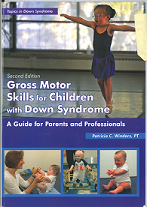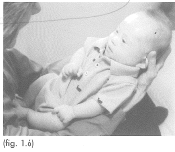
Physical Therapy Exercises Parents Can Do with Babies with Down Syndrome
Simple Activities for the Birth-to-Walking Period of Development

Featured Exercises for Children Born with Down Syndrome in the Birth to Walking Stage
- Back-Lying in Your Lap (below)
- Back-Lying and Reaching Upward without Support
- Hip Stretch
- Supported Kneeling at a Sofa Cushion
Back-Lying Exercises for Babies Birth to Walking
Components
When your baby is on her back, the components you want her to develop are:
- Head in midline and tucking her chin
- Hands to her chest (midline) and beginning reaching toys
- Legs supported together with hips and knees bent, feet on the floor, and knees together; also kicking movements
These movements will take time to develop and you will need to support her fully in the beginning. If she is supported in the right way, she can focus her attention on you and respond to you.
Tendencies
Her tendency will be:
- to turn her head to one side and maintain her head there
- to rest her arms on the surface and infrequently move them to the midline
- to activate her legs since they are the strongest part; this will prevent arm movements because the young infant cannot move arms and legs at the same time
- to position her legs in the "frog leg" position (hips and knees bent and knees wide apart) when at rest, and to develop muscle tightness if she habitually uses this posture
- to use the arching pattern in the head, arms, and trunk, which inhibits chin tuck and moving the hands to the midline
If your baby is not supported, her head will be turned to one side, her arms and hands will rest on the surface, and her legs will be positioned with her hips and knees bent and her knees wide apart or she will do kicking movements. With the activity of her legs, she will not have the strength to move her head to the center to look at you or to lift her arms so she can bring her hands and mouth to her chest. With the tendency of arching, she will pinch her shoulder blades together and her upper chest will puff up and this will prevent chin tuck and moving her arms to the midline. She may also learn to stabilize her arms against the surface to be able to kick her legs more.
Activity: Back-Lying in Your Lap

- Place your baby in your lap as you sit on the couch or other comfortable chair with back support.
- Place her with her head between your knees, her hips against your abdomen, and her legs supported against your chest.
- Slide your hands along the sides of her body and under her arms until they are under her head. Hold her head in the center and tilt it upward so she sees you easily.
- With this arm support, she will be able to bend her elbows and bring her hands to her chest or mouth.
- Use your elboes to support her legs so that her knees are in line with her hips and not in a wide position.
- Lean your head and trunk forward so taht you can be close to her and you can see each other. Talk or sing to her and engage with her for as long as tolerated.
Next, try these physical therapy exercises to help foster gross motor development in babies with Down syndrome:
If your child with Down syndrome is in the Post Walking phase of development, read this chart on the average ages to achieve the gross motor goals of the post walking period for children with Down syndrome.
These exercies are excerpted from Gross Motor Skills for Children with Down Syndrome: A Guide for Parents and Professionals, 2nd edition, by Patricia C. Winders, PT (Woodbine House, 2014).


 By Mids Meinberg
By Mids Meinberg By Mids Meinberg
By Mids Meinberg





Connect with us on social media